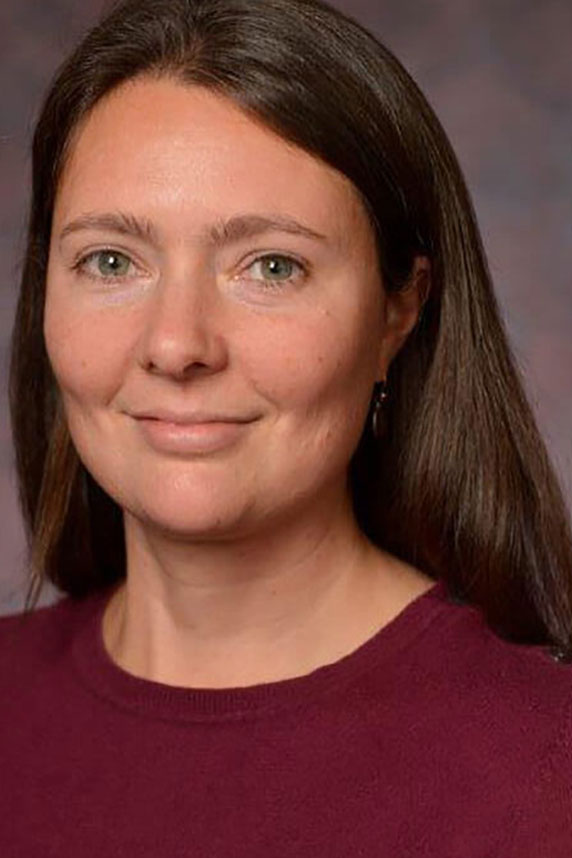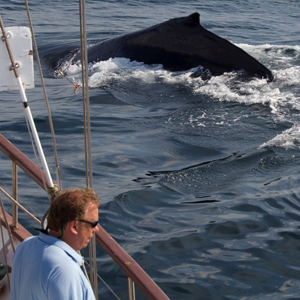Tiny particles inhaled during pregnancy could affect fetal growth and development, according to research in animal models funded by the NIEHS Outstanding New Environmental Scientist Program (ONES) program.
 At Rutgers, Stapleton is an assistant professor in the Ernesto Mario School of Pharmacy, and the Joint Graduate Program in Toxicology. (Photo courtesy of Phoebe Stapleton)
At Rutgers, Stapleton is an assistant professor in the Ernesto Mario School of Pharmacy, and the Joint Graduate Program in Toxicology. (Photo courtesy of Phoebe Stapleton)Phoebe Stapleton, Ph.D., an assistant professor at Rutgers Ernest Mario School of Pharmacy and a faculty member at Rutgers Environmental and Occupational Health Sciences Institute, has focused her ONES research on understanding the molecular mechanisms that impair blood flow to a developing fetus after exposure to environmental contaminants during pregnancy.
Using a rat model, Stapleton showed that nanosized pieces of the metal titanium dioxide inhaled by a pregnant rat could cross from the rat’s lungs into the placenta. A function of the placenta is to filter out substances that could harm the fetus. Stapleton’s work has shown that in the case of nanoparticles, the placenta is not an effective barrier.
The research is rooted in the question of whether such exposures lead to restrictions of maternal blood flow, which in turn can cause low birth weights, early delivery, and even miscarriage.
“The maternal exposure is impairing systemic blood flow overall,” Stapleton said. “There’s a clear downstream effect. There may be reduced blood flow in the liver of a nanoparticle-exposed male. But in a female animal that is pregnant, you can see impairment in fetal pups. There is a systemic, more visual, and tangible generational effect to maternal impairment in blood flow.”
While Stapleton’s work is ongoing, an hypothesis of her ONES grant is that increased folic acid intake during pregnancy can help negate the worst effects of blood flow restriction.
The ubiquity of nanoparticles
Metal nanoparticles are not Stapleton’s only concern. Her research also looks at another potential threat to fetal health: plastic nanoparticles. With the sheer amount of microplastics now present in the environment, inhaling or ingesting plastic nanoparticles is unavoidable.
The fact that nanoparticle contamination is so widespread has made Stapleton’s research particularly challenging. During her work with the pregnant rats exposed to titanium dioxide, her team discovered that their control animals had very high amounts of titanium likely due to the chow the rats were being fed.
“We ended up with an ingestion exposure in the controls and then an ingestion and inhalation exposure in the primary group,” she noted. “That said, this probably provides a more accurate picture of what’s actually happening in the world outside the controlled conditions of the lab.”
Stapleton noted the same issue has arisen in experiments involving plastics. Her team has noticed that many components in labs such as bottles, flasks, and pipettes are made of plastics. The trick is to use sophisticated technologies such as transmission electron microscopy and dark field microscopy to look for the specific polymer used for exposure during the experiment as opposed to other polymers contaminating the surrounding environment.
Unintentionally bionic
Having discovered that nanoparticles can affect blood flow and cross from maternal lungs and digestive tracts into fetal tissues and the brain, Stapleton’s next research question is whether those particles remain after birth.
“Can you be born with these materials already in you?” Stapleton asked. “Could particle translocation change the physiology of the next generation? We know these particles now have local cellular interactions with placental tissues — what’s the toxicological implication?”
Particles have been getting into our bodies since our ancient ancestors discovered how to make fire, as ultrafine nanosized particles are aerosolized when matter burns. But technological advances have now given us the capability to identify the particles we are inhaling.
“When we consider neurological disorders or disease states that we don’t know where they’re coming from, it begs the question whether particle interaction on a cellular level is playing a role for some of them,” she said.
Stapleton said that she hopes an eventual outcome of her research is its potential policy implications, though she admits that it can be difficult to control or regulate a contaminant we do not fully comprehend. And while technological advances are needed, especially to sort through simultaneous exposures to such tiny particles, Stapleton’s model and continuing research have shed light on the importance of understanding the effects of exposures on maternal and fetal health.
“The discovery that titanium dioxide can migrate from the mother’s lungs to the placenta and other fetal tissues is significant,” said Lingamanaidu (Ravi) Ravichandran, Ph.D., a health scientist administrator in the NIEHS Exposure, Response, and Technology Branch who oversees Stapleton’s work. “The model could provide a way to further understand the biological consequences after acute or chronic nanoparticle exposures, particularly their effect on maternal health and pregnancy outcomes.”
Citation: D'Errico JN, Doherty C, Reyes George JJ, Buckley B, Stapleton PA. 2022. Maternal, placental, and fetal distribution of titanium after repeated titanium dioxide nanoparticle inhalation through pregnancy. Placenta 121:99–108.
(Kelley Christensen is a contract writer and editor for the NIEHS Office of Communications and Public Liaison.)









